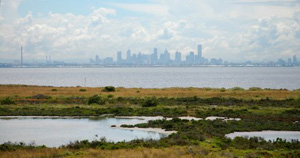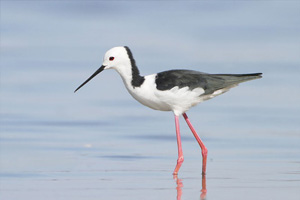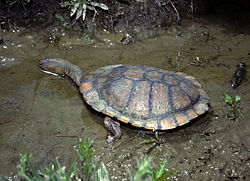Tom Parkinson's monthly column, introducing the diverse range of flora and fauna on show at Sanctuary Lakes.
 Last month's Natures Rubik (Stroll along the Boulevard - part 1) finished at the furthest South East position of the Lake, the Slipway. Continuing our Boulevardier around the estate, let's take a slight diversion by crossing the road over the Slipway Bridge towards Cheetham Wetlands. At the end of the bridge you will see a walkway which runs along the edge of the wetlands. From the walkway, on a clear day you are immediately hit by a magnificent view of the Melbourne CBD, romantically rising like a modern mythical city in a misty blue from out of Port Phillip Bay.
Last month's Natures Rubik (Stroll along the Boulevard - part 1) finished at the furthest South East position of the Lake, the Slipway. Continuing our Boulevardier around the estate, let's take a slight diversion by crossing the road over the Slipway Bridge towards Cheetham Wetlands. At the end of the bridge you will see a walkway which runs along the edge of the wetlands. From the walkway, on a clear day you are immediately hit by a magnificent view of the Melbourne CBD, romantically rising like a modern mythical city in a misty blue from out of Port Phillip Bay.
As you stroll along the walkway looking down at the Cheetham Wetlands with its tidal pools, salty mud pans and artificial lagoons, you get a reminder of the original Sanctuary Lakes landscape. Cheetham Wetlands are a natural bird haven. These internationally significant wetlands provide important feeding and habitat areas for thousands of migratory birds from Japan, Siberia and New Zealand. More than 200 species have been recorded by Parks Victoria, 34 of which are covered by international migratory agreements.
 Black Winged Stilt (Himantopus himantopus) One of the most common water birds on the Wetlands is the Black Winged Stilt (Himantopus himantopus). The Black-winged Stilt is a large black and white wader with long orange-red legs and a straight black bill. It has black on the back of the neck, a white collar and a red iris eyes. Unfortunately its call, a repeated high-pitched barking noise, is extremely untuneful. But it is very social bird who lives in small groups, wading for food, around the shallow edges of the mudflats and marshes. They feed mainly on aquatic insects, molluscs and crustaceans. They rarely swim for food, preferring instead to wade in shallow water, and seize prey on or near the surface.
Black Winged Stilt (Himantopus himantopus) One of the most common water birds on the Wetlands is the Black Winged Stilt (Himantopus himantopus). The Black-winged Stilt is a large black and white wader with long orange-red legs and a straight black bill. It has black on the back of the neck, a white collar and a red iris eyes. Unfortunately its call, a repeated high-pitched barking noise, is extremely untuneful. But it is very social bird who lives in small groups, wading for food, around the shallow edges of the mudflats and marshes. They feed mainly on aquatic insects, molluscs and crustaceans. They rarely swim for food, preferring instead to wade in shallow water, and seize prey on or near the surface.
Black-winged Stilts nest in small colonies; the nest may be anything from a simple shallow scrape on the ground to a mound of vegetation placed in or near the water. Both sexes incubate the eggs and look after the young.
Further along the walkway you come to the Foot and Bike Bridge that crosses the Skeleton Creek and heads towards Altona. Walk to the centre of the Bridge and look down into the Creek on the left or riverside. Assuming that the Creek water is clear (unfortunately some days it isn't) you will see on the Creek bed what could look like large dark brown, river smoothed stones. Be patient for a few moments and you will see four legs and a neck extend out from the stones and as it starts to move you realise you are looking at a small colony of Long-necked Turtles (Chelodina longicollis).
 Long-necked Turtle (Chelodina longicollis) The Long-necked Turtle is true to its name; a Turtle's shell can grow up to 25cm, with a neck that is sometimes longer than the full length of its shell. The neck's length allows it to be used as a unique hunting mechanism. By bending its neck under its shell, the turtle will get close to its prey and then strike by a swift extension of its neck, similar to the action of a snake.
Long-necked Turtle (Chelodina longicollis) The Long-necked Turtle is true to its name; a Turtle's shell can grow up to 25cm, with a neck that is sometimes longer than the full length of its shell. The neck's length allows it to be used as a unique hunting mechanism. By bending its neck under its shell, the turtle will get close to its prey and then strike by a swift extension of its neck, similar to the action of a snake.
The Long-necked Turtle is carnivorous and commonly feeds on fish, insects, tadpoles, frogs, yabbies and other crustaceans. Their feet and claws are very strong and are webbed for swimming and tearing apart large food items. With strong jaws they can have quite a nasty bite so be careful when touching or aggravating them.
The shell is known as a "carapace", which can vary from a rich brown to a dark brown. In the lighter coloured turtles you can clearly see the black outlines across the shell. On the lower part of the shell (plastron) yellow markings can be seen with the black outlines.
The Long-necked Turtle will breed during December to February when they are most active. The female lays approximately 4-20 eggs each year with a 4 month incubation. Summer months are the most active for this turtle. During winter they become dormant residing under leaves or logs.
The Long-necked Turtle can live up to 50 years.
One note of warning if you get the urge to pick up a Long Necked Turtle and can avoid the bite. They have a second great defence mechanism, an ability to omit a foul smell from their glands which they are able to spray as far as 3 metres. It will take a full cycle wash to rid the odious smell from your clothes.
Walking back off the bridge and towards Beach Walk you will see a 2x1 metre metal casing which contains a small pump between two large muddy ponds. These muddy ponds are named Cheetham Creek and it is the water out of these ponds that controls the salt levels for the main Sanctuary Lake. The salty water is pumped underground and piped through the Lake to the Grand Canal. As I mentioned in the part one "Stroll", the pipe can be seen underwater from the South Boulevard's Grand Canal Bridge where it disperses its contents at the Point Cook Road end of the Canal.
You can at this point take Beach Walk and re-join East Boulevard or take the footpath that runs alongside Skeleton Creek and join the North Boulevard at the Breezewater Reserve. This time I am following the Skeleton Creek, where the footpath meanders the seven settlement ponds that feed the lake.
Using its full geographical title, the Skeleton Waterholes Creek is a waterway that runs 30 plus kilometres through Victoria’s central south-western Basalt plain. The creek originates near Mount Cottrell, to the south of Rockbank, and passes through rural land until it reaches the new suburban area of Tarneit, then on to Hoppers Crossing and Point Cook.
The settlement ponds take in the water run-off from the surrounding roads and a small amount from the Creeks overflow. Last Boulevard Rubik asked the question:
"How many litres does the Lake evaporate on one hot day?"
Answer: FOUR MILLION LITRES
It is no wonder we need a dozen adjacent settlement ponds and a canal feeding the Lake.
Unfortunately the settlement ponds between Breezewater Reserve and Skeleton Creek are not as open as they could be thanks to the infestation of Typha Comungi (Australian Bulrush) along the Creek.
Ornithologist Bob Winters and his team of Creek activists have done a wonderful job cleaning up the creek, but the Bulrushes are very determined plants. It is made that bit more complicated as the herbicide possible to control the Comungi should not interfere with the water quality. Nevertheless the Point Cook section of Skeleton Creek Waterway is looking good and attracting numerous species of fauna, both feathered and furry.
At Breezewater Reserve, you can join the North Boulevard and in a further kilometre plus you complete the circuit of the Estate. Enjoy, it all belongs to us.
As we stroll along the Boulevard
With an independent air
you can hear us all declare
"We must be a Millionaire."
English Music Hall Song; by Fred Gilbert 1892